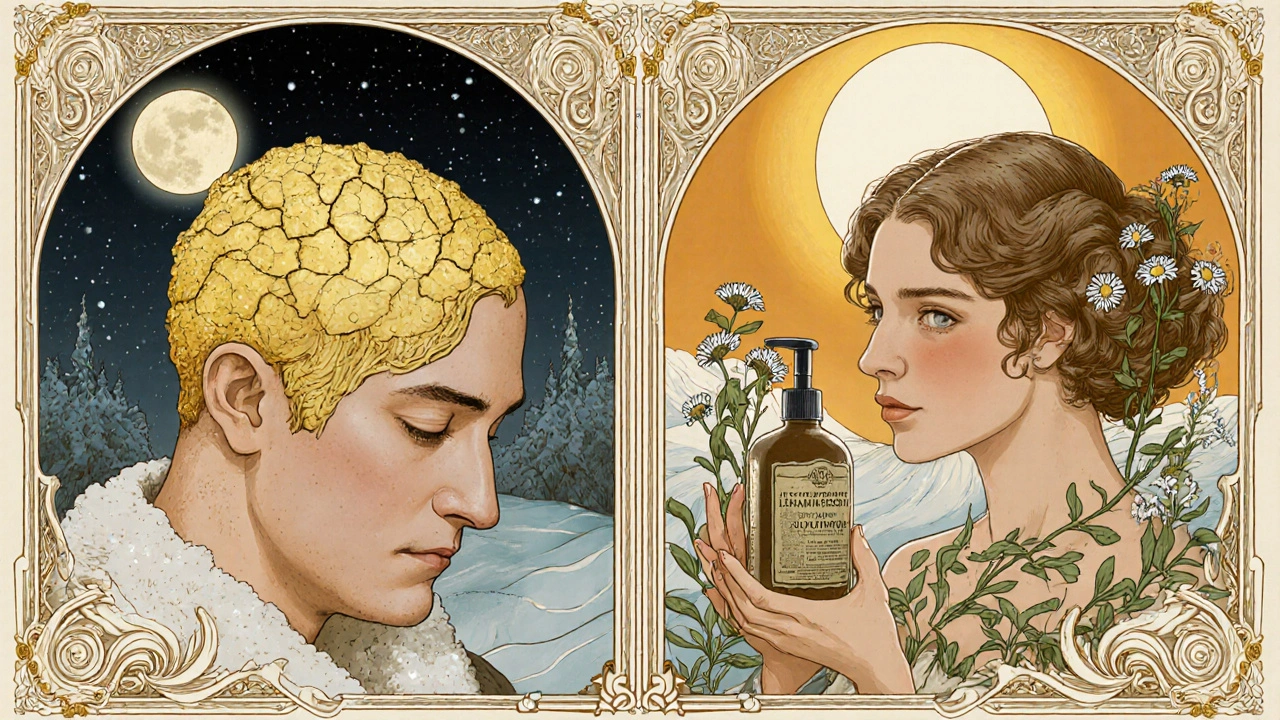Flakes on your scalp that won’t wash out. Itchy, greasy patches behind your ears or along your eyebrows. You’ve tried every anti-dandruff shampoo in the store, but nothing sticks. If this sounds familiar, you’re not alone. About 50% of adults will deal with seborrheic dermatitis at some point in their lives. It’s not dirt. It’s not an allergy. And no, you can’t just scrub it away.
What’s Really Going On With Your Scalp?
Seborrheic dermatitis isn’t just "bad dandruff." It’s an inflammatory skin condition tied to a yeast called Malassezia - a microbe that lives naturally on everyone’s skin. Normally harmless, it starts causing trouble when it overgrows. This yeast feeds on the oil your skin produces. When it breaks down that oil, it releases fatty acids that irritate the skin, triggering inflammation and speeding up skin cell turnover. Instead of shedding slowly and invisibly, your scalp cells pile up in thick, white or yellowish flakes. This isn’t contagious. You didn’t catch it from someone. It’s not caused by stress alone, though stress can make it worse. Genetics play a role. So do weather, hormones, and even neurological conditions like Parkinson’s disease - people with Parkinson’s are 4 to 5 times more likely to develop it. Cold, dry winter air makes symptoms flare in 75% of cases. Sunlight helps, which is why many notice improvement in summer.Why Regular Shampoos Don’t Work
Most drugstore shampoos only clean. They don’t touch the root cause. If your scalp is flaking because of yeast overgrowth and inflammation, you need ingredients that fight both. Regular dandruff shampoos with mild detergents might give you temporary relief, but they won’t stop the cycle. The key is targeting the yeast and calming the skin at the same time. The most effective medicated shampoos contain one or more of these active ingredients:- Ketoconazole (2%) - A powerful antifungal that directly reduces Malassezia yeast. Often the first choice for moderate to severe cases.
- Zinc pyrithione (1-2%) - Antifungal and anti-inflammatory. Gentle enough for daily use, great for mild cases.
- Selenium sulfide (2.5%) - Slows skin cell turnover and kills yeast. Can discolor light hair if used too often.
- Ciclopirox (1%) - Prescription-strength antifungal with anti-inflammatory effects. Works well when other options fail.
- Coal tar (0.5-5%) - Slows down skin cell growth. Smells strong but works for stubborn cases. Often used in rotation.
- Salicylic acid (1.8-3%) - A keratolytic that dissolves flakes and helps other ingredients penetrate better.
How to Use Medicated Shampoos Right
Using these shampoos like regular hair washes won’t cut it. You need to treat them like medicine. Start by applying the shampoo directly to your scalp - not just your hair. Massage it in well. Then, leave it on for 5 to 10 minutes before rinsing. This gives the active ingredients time to work. Rinse too soon, and you’re wasting the treatment. For initial control, use it every day or every other day for 2 to 4 weeks. Once the flaking stops, cut back to once or twice a week to keep it under control. Stopping completely? Flakes usually return within 2 to 4 weeks. Many people find that rotating shampoos works better than sticking to one. For example:- Monday: Ketoconazole
- Wednesday: Zinc pyrithione
- Friday: Coal tar

What About Hydrocortisone Cream?
If your scalp is red, swollen, or burning, a short-term topical steroid like hydrocortisone 0.5% or 1% can help calm the inflammation. You can buy this over the counter. Apply it sparingly to the affected scalp areas - not your hairline or face - once or twice a day for no more than 1 to 2 weeks. Don’t use steroid creams long-term. They thin the skin and can cause rebound flares. They’re best used as a bridge - to get you through a bad flare while the antifungal shampoo does its job. For facial seborrheic dermatitis (like around the nose or beard), shaving can help. One study found 37% of men with beard involvement saw clearance just by shaving regularly and using antifungal washes.Common Problems and How to Fix Them
My hair feels dry and brittle. That’s normal. Antifungal shampoos strip oil. Use a lightweight conditioner only on the ends of your hair, not the scalp. Look for sulfate-free formulas to avoid further irritation. The shampoo smells awful. Coal tar and selenium sulfide have strong odors. If that turns you off, try ketoconazole or zinc pyrithione - they’re much milder. I got worse before I got better. In the first week or two, some people notice increased flaking. This is the dead skin shedding. Stick with it. If it doesn’t improve after 3 weeks, switch formulas. I tried everything and nothing works. Talk to a dermatologist. You might need a prescription shampoo like ciclopirox or a combination therapy. Some people benefit from antifungal creams applied directly to the scalp, or even light therapy.
Long-Term Management Is the Only Cure
There’s no permanent cure for seborrheic dermatitis. But there is control. Think of it like managing high blood pressure - you don’t cure it, but you keep it from causing problems. The goal isn’t to eliminate the yeast. That’s impossible. The yeast is always there. The goal is to keep its population in check so your skin doesn’t react. That means ongoing maintenance. Even when your scalp looks perfect, keep using a medicated shampoo once or twice a week. Avoid triggers where you can. Stress, heavy alcohol use, and harsh hair products (like gels or sprays with alcohol) can all make flare-ups worse. Use gentle, fragrance-free hair care. Wash your pillowcases weekly. Keep your scalp clean but don’t overwash - that can strip natural oils and trigger more oil production.What About Natural Remedies?
Tea tree oil, apple cider vinegar, and coconut oil get a lot of attention online. But there’s little scientific proof they work for seborrheic dermatitis. Tea tree oil has some antifungal properties, but it can irritate the skin if not diluted properly. Coconut oil might feed the yeast since it’s a fat source. Don’t waste time on unproven fixes. Stick with what’s been tested - medicated shampoos.When to See a Doctor
You don’t need to see a doctor for mild flaking. But if:- Your scalp is bleeding, oozing, or crusted
- The flaking spreads to your face, chest, or other areas
- Itching is severe and keeps you up at night
- Over-the-counter shampoos haven’t helped after 4 weeks
Seborrheic dermatitis is frustrating, but manageable. With the right shampoo, the right routine, and patience, you can go from daily flaking to a clean, comfortable scalp - without harsh chemicals or endless trial and error.
Is seborrheic dermatitis the same as dandruff?
Dandruff is a mild form of seborrheic dermatitis that only affects the scalp. Seborrheic dermatitis can also appear on the face, ears, chest, and eyebrows. Dandruff usually just causes white flakes without redness or itching. Seborrheic dermatitis often includes greasy, yellowish scales and inflammation.
Can kids get seborrheic dermatitis?
Yes. In babies, it’s called cradle cap. It shows up as thick, yellow, greasy scales on the scalp, sometimes spreading to the eyebrows or diaper area. It’s harmless and usually clears up on its own within a few months. Gently brushing the scalp with a soft brush and washing with a mild shampoo helps. If it persists or spreads, talk to a pediatrician.
How long does it take for medicated shampoos to work?
Most people see improvement in 1 to 2 weeks with consistent use. Full control usually takes 4 to 6 weeks. Some notice a temporary increase in flaking during the first week - that’s the dead skin shedding. Don’t quit too soon. Stick with the routine for at least 3 weeks before deciding if it’s working.
Can I use medicated shampoo every day?
Yes - but only during the initial treatment phase, usually for 2 to 4 weeks. Daily use helps get symptoms under control fast. Once your scalp clears, switch to maintenance: once or twice a week. Using it too often long-term can dry out your hair and scalp, making the problem worse.
Why do I need to rotate shampoos?
The yeast that causes seborrheic dermatitis can become resistant to one ingredient over time. Rotating between different active ingredients - like ketoconazole one week, zinc pyrithione the next - keeps the yeast from adapting. About 45% of people need to rotate to keep symptoms under control long-term.
Will stress make my seborrheic dermatitis worse?
Yes. Stress is one of the top triggers. About 60% of people report flare-ups during stressful periods - like exams, job changes, or illness. Managing stress through sleep, exercise, or mindfulness won’t cure it, but it can reduce how often and how badly you flare.
Is there a cure for seborrheic dermatitis?
No. There’s no permanent cure. But with consistent use of medicated shampoos and avoiding triggers, most people can keep symptoms under control for months or years. Think of it like managing chronic conditions - you don’t eliminate the cause, you manage the response.







Scott Macfadyen
November 18, 2025 AT 00:28Been fighting this for years. Ketoconazole saved my life. Used to look like I had snow on my shoulders in winter. Now I rotate it with zinc pyrithione every other wash and I’m good for months. No more itching, no more shame. Just don’t rinse too fast - five minutes is non-negotiable.
Ancel Fortuin
November 19, 2025 AT 01:34Of course the medical establishment wants you to buy shampoos. Meanwhile, the real cause is glyphosate in your bread and fluoridated water. Malassezia? That’s just a scapegoat. Try clay masks and fasting. I cured my ‘dermatitis’ after 14 days of lemon water and avoiding 5G towers. The FDA doesn’t want you to know this.
Hannah Blower
November 19, 2025 AT 09:56How tragically predictable. Another ‘guide’ that pathologizes natural biological variation under the guise of ‘medicine.’ You’re treating a symptom of systemic dysbiosis with topical antifungals like some kind of biochemical band-aid. The real issue? Industrialized diets, cortisol dysregulation, and the collapse of microbial symbiosis. But sure, scrub your scalp with ketoconazole and call it a day. It’s easier than confronting the collapse of modern living.
Alex Czartoryski
November 21, 2025 AT 05:07Bro, coal tar smells like a tire fire. I used it once. My girlfriend left me. Not because of the smell - she’s chill - but because I started wearing a gas mask to bed. Just use zinc pyrithione. It’s like the gentle giant of scalp care. No drama, no odor, just results. And yes, I’ve tried everything. Even the ‘natural’ stuff. Don’t be that guy.
Gizela Cardoso
November 22, 2025 AT 21:51Thank you for this. I’ve been too embarrassed to ask anyone about this. I thought it was just me being ‘dirty’ or not washing enough. Knowing it’s yeast and not my fault? Huge relief. I’m trying ketoconazole this week. Fingers crossed.
Denise Cauchon
November 23, 2025 AT 04:42OMG I’m not alone?? 😭 I thought I was the only one who looked like a walking snow globe in January. I’ve been using Nizoral for 3 months now and I’m basically a new person. Also, I cry every time I see a sunbeam on my scalp. Nature is healing. 💖
Andrea Johnston
November 23, 2025 AT 23:39Let’s be real - this is just the scalp’s way of screaming ‘I’m under too much stress and you’re eating too much sugar.’ You can douse it in antifungals all day, but until you fix your sleep, your cortisol, and your obsession with oat milk lattes, it’s just whack-a-mole. And yes, I’ve been there. Twice. The answer isn’t in the bottle. It’s in the mirror.
Chloe Sevigny
November 25, 2025 AT 11:36One must interrogate the epistemological framework underpinning the medicalization of seborrheic dermatitis. The discourse surrounding Malassezia as a pathogen is a product of biomedical hegemony - a reductionist paradigm that obscures the phenomenological experience of cutaneous dysregulation. One is left to wonder: is the yeast the cause, or merely the symptom of a deeper ontological rupture between the self and its ecological milieu? The prescribed regimen, while pragmatically efficacious, remains a palliative artifact of a medical-industrial complex that commodifies bodily dysfunctions as consumable pathologies. One might consider, instead, the Aristotelian notion of balance - a return to humoral equilibrium through dietary austerity and circadian alignment. But alas, we live in an age of convenience, where efficacy trumps wisdom.
Gregory Gonzalez
November 26, 2025 AT 14:11Interesting how everyone ignores the fact that 75% of people who use these shampoos still get flaking. The real answer? Your scalp is just tired of being abused. Wash less. Use water only for a month. Let your natural oils regulate. No chemicals. No ‘rotating.’ Just… stop. You’ll be surprised. I did. And now my scalp doesn’t feel like a science experiment.
Victoria Malloy
November 28, 2025 AT 12:55You’re not broken. You’re just trying to fix something that’s not broken - it’s just different. I used to stress about it too. Now I just use zinc pyrithione twice a week and call it a win. No guilt. No drama. Just clean scalp and peace of mind. You’ve got this.
Ronald Stenger
November 29, 2025 AT 04:58Canada’s got the best shampoos. America’s still stuck in the 90s with tar and selenium. I moved here from Texas. My scalp went from ‘war zone’ to ‘spa day’ in two weeks. Don’t buy American crap. Get Nizoral from Canada. It’s not just better - it’s a patriotic duty.